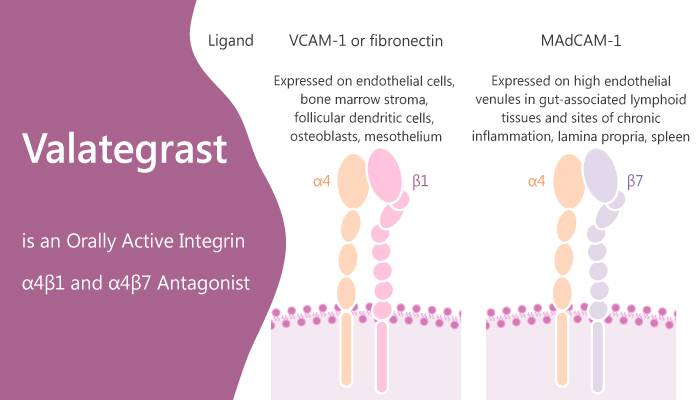Asthma is an inflammatory disorder of the airways. Moreover, asthma is a long-term disease of the lungs. The features of asthma pathophysiology are the production of cytokines and infiltration of the airways by eosinophils, mast cells, T and B lymphocytes, macrophages, and neutrophils. Integrins are a family of adhesion molecules responsible for transmembrane signaling by undergoing conformational rearrangements. Integrins involve a wide range of biological processes, such as inflammation, cancer, and hemostasis. Especially, Valategrast is a dual α4β1-α4β7 integrin antagonist.
Anti-R4 antibodies and blocking peptides are efficacious in a number of animal models of inflammatory diseases. Subsequently, researchers discovered a small molecule VLA-4 antagonist Valategrast (R411). Valategrast is beneficial for the treatment of asthma.

VLA-4 (α4β1, CD49d/CD29) is a member of the integrin family. VLA-4 binds strongly to ligands including (1) vascular cell adhesion molecule-1 (VCAM-1), and (2) the CS-1 domain of fibronectin (FN). The α4β7 integrin is heterodimeric cell surface receptors expressing on most leukocytes. In particular, Valategrast targets the inflammatory process in respiratory airways. Furthermore, Valategrast has shown good efficacy in animal disease models and is currently under development for the treatment of chronic asthma. Following oral administration, Valategrast is rapidly and completely biotransformed into its active metabolite, RO0270608, which is mainly eliminated by biliary excretion.
RO0270608, the active metabolite of Valategras, is a dual α4β1-α4β7 antagonist with high affinity for the activated states of both α4β1 and α4β7 integrins, but the affinity is lower and the dissociation is rapid when the receptors were not activated.
All in all, Valategrast (R411) is an oral, dual α4/β1 and α4/β7 integrin antagonist acts as an asthma controller.